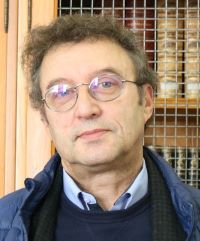
O. Murat Ozkendir
Tarsus University, Turkey
Talk: Absorption Spectroscopy Analysis of Ionic Activity in -NaFeO2 at Varying Temperatures
Abstract:To investigate the effect of heat on the electronic, crystal structure, and ionic conductivity properties of β-NaFeO2 materials, a temperature-dependent ionic activity investigation of the sodium oxide material was performed. To demonstrate the physical background impact of temperature change on material atoms, x-ray absorption (XAS) and x-ray absorption fine structure (XAFS) spectroscopy data were collected and processed at comparable temperatures. Among the materials, sodium atoms were shown to be the most responsible for ionic conductivity loss as temperature increased. When sodium atoms detach from the spinel structure of the Fe-O ligand, their ionic capacitance increases as the temperature rises, resulting in decreased ionic conductivity. Soft x-ray XAS and XAFS studies were carried out to study the temperature-related background process. The XAFS data were collected from the Fe K-edge, whereas the soft x-ray XAS data were obtained from the Fe L3,2-edge and the O K-edge. Corresponding investigations confirmed an exceptionally stable (FeO2)-ligand structure; however, as the temperature rises, sodium atoms become partially free, causing an increase in ionic resistance via Coulombic interactions. The temperature was elevated to 100 °C to investigate how temperature affects the β-NaFeO2 material. This caused a substantial release of sodium atoms, which were determined to be bonded to the ligand as “Na+(FeO2)-” after cooling to create the β-NaFeO2 material.

Jean-François Bardeau
Université du Mans, France
Talk Title: Raman detection of analytes in the 10-6 – 10-8 M range: Highlight on commercial SERS substrates and on a low-cost nano-rough gold substrate
Biography: Jean-François BARDEAU est Directeur de Recherche au CNRS à l’Institut des Molécules et Matériaux du Mans (IMMM) de l’Université du Mans. Il s’est spécialisé dans l’étude des propriétés structurales et dynamiques de différentes classes de matériaux dont les matériaux hybrides organique/inorganiques et les biomatériaux (bio-minéralisation de mollusques marins à coquille unique et bivalves, pigments).
Plus récemment, il a orienté une partie de ses recherches sur la compréhension des phénomènes d’exaltations électromagnétiques associés aux systèmes confinés et nanostructurés pour développer des capteurs SERS (surface enhanced. Raman scattering) robustes, fiables et reproductibles en vue d’ applications dans les domaines de la santé et de l’environnement.
Abstract: Surface Enhanced Raman Spectroscopy (SERS) is a powerful non-invasive technique that is increasingly used to detect and identify traces of molecules. Although the sensitivity of SERS-active substrates is widely recognized, most of the applications have been severely limited by the low reproducibility, very small active surface area and high manufacturing cost of substrates. Today, commercial SERS substrates can be purchased, but because the manufacturing processes are generally different, the surface quality is not equivalent, nor are the enhancement factors and the reproducibility from one batch to another.
We have recently investigated and compared the efficiency of three different commercial SERS substrates and our home-made optimized nanorough substrate to detect a standard target molecule, thiophenol in alcoholic solution diluted at 10-6 M and 10-8 M. The spectral quality, signal homogeneity, distribution of intensity and thermal stability under laser beam will be discussed. Finally, I will show how our nanorough gold substrate can be used to detect and identify model molecules in binary systems by using statistical tools and multivariate data analysis.
 Lotfi Bessais
Lotfi Bessais
University of Paris-Est Creteil, France
Talk Title: Multifunctional Co-based intermetallic alloys
Biography: Lotfi Bessais is a professor at the University of Paris-Est Creteil, France. He obtained a doctorate degree and HDR from the University of Paris 7, France. His research interests cover a broad range including nanomagnetic intermetallic materials.
Abstract: Multifunctional R-Co (R= rare earth) intermetallic alloys exhibit performant magnetic, magnetocaloric and important hydrogenation properties. Samples were prepared by high-energy ball milling followed by an optimized heat treatment.
Structural properties were determined using x-ray powder diffraction, while local environment around each cobalt atom were studied utilizing synchrotron beam local probes. Magnetic and magnetocaloric measurements were performed using a Quantum Design magnetometer.
Ab initio FP-LAPW calculations combining density functional theory and the full-potential linearized augmented plane wave method are performed to investigate the electronic and magnetic structure of the Co-based intermetallic alloys. The calculated magnetic moments are in good agreement with the experimental measurements.
The maximum hydrogen absorption content of R-Co reached 1.2 H/M (H/M: hydrogen per metal). High coercivity of 1.7 T are obtained for theses alloys after an optimization of their microstructure. In addition, these uniaxial anisotropic compounds exhibit a large magnetic entropy change at Curie temperature with a magnetocaloric effect equal to 6 J/(kg.K) under low magnetic field of 0-1T. These results indicate that, these nanomaterials are suitable for hydrogen storage, permanent magnet applications and for magnetic refrigeration.

Rui Fausto
University of Coimbra, Portugal
Talk Title: Design, Synthesis and Characterization of Novel Materials Exhibiting Color Polymorphism
Abstract: Color polymorphism is an interesting property of chemical systems which present crystal polymorphs of different colors. In the case of organic molecular crystals, color polymorphism is a rare phenomenon, with only a few examples reported in the literature hitherto. Nevertheless, systems exhibiting color polymorphism have many potential applications in different domains, such as pigment, sensor, and technology industries.
In this lecture, a series of new chemical systems exhibiting color polymorphism will be described. These new systems have expanded the range of colors of the polymorphs of organic molecular crystals, which traditionally were limited to the triad red-orange-yellow, to the green color.
The pathway to these discovers will be presented, starting with the design and synthesis of the compounds, screening of the polymorphs and their physicochemical characterization. A rationalization on the major structural factors responsible for the different colors of the polymorphs will be presented.

